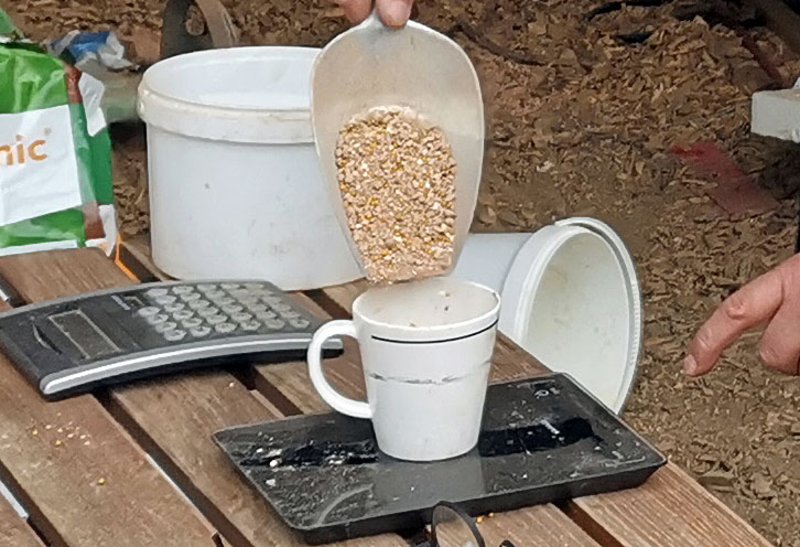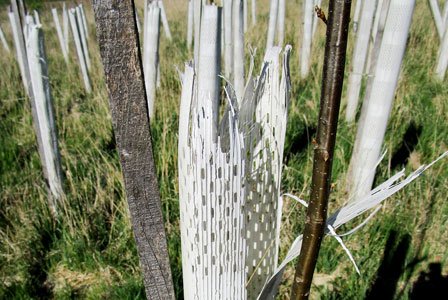
Fig. 1: Super-absorbent granules
Photo: Martin Roth
On the use of super-absorbers in the forest
It would be impossible to imagine our day-to-day lives without plastics [1]. Germany uses around 14 million tonnes of plastic per year - more than any other country in Europe. Plastics have very different levels of persistence in the environment [4] and can therefore become a problem if they enter the environment in an uncontrolled way. Macro-, micro- and nanoplastics [3] in particular are hardly recoverable. They are thus increasingly becoming the focus of attention. Super-absorbent polymers are a special form of microplastic. These petroleum-based synthetic polymers are found in nappies, among other things, and can store and release many times their own weight in water. The idea of introducing them into the soil as an agent to increase the water-retention capacity of the soil originally came from agriculture. They are used in combination with irrigation on sandy soils in arid climates.
Recently, super-absorbers for use in the forest have been presented to forest owners and in the forestry trade press (cf. also specialist catalogues in the forestry mail order trade). It is directly or indirectly pointed out that their use can improve the survival rate of young plants. This is a product promise that could merit attention, particularly after the last three dry and hot years.
Current state of knowledge
We would therefore like to present our current state of knowledge on the use of super-absorbent polymers in forests. The key to a sustainable and close-to-nature management strategy is how to ensure biodegradability. However, manufacturers often lack precise information on the complete biodegradability of their products or their harmlessness (or ecological performance) in forest soils. So far, there are no certificates or even standards on degradability that meet the special requirements of a sustainable and close-to-nature forestry management style for products to be biodegradable and residue-free under forest conditions. Likewise, the interactions of super-absorbers with bacteria, micro-organisms, earthworms and the entire subsequent food chain are not known, or are only insufficiently known (e.g. [10]). Even in the inanimate soil environment (physical, chemical soil properties, e.g. humic substances), there may be negative or at least unclear effects on processes and functions (e.g. [2]).
An enquiry registered with a large producer of superabsorbents resulted in the answer that this product is not completely degradable, and an organic residue remains. The introduction of super-absorbers into forest soils through planting can thus be quite problematic, and cannot be recommended under the current state of knowledge.
Effectiveness and alternatives
For forest owners, there is also the question of effectiveness. Prolonged rainfall cannot be replaced by the use of powders and tablets, or only inadequately. In the absence of precipitation, the super-absorbent polymers cannot swell at all in the first place, and the development of a culture just as a dry phase starts remains problematic. Previous trials with super-absorbers have not been shown to increase the survival rate of forest plants ([5, 12, 13]) or improve vitality [11]. Depending also on further (product) development and independent scientific product testing, we therefore see a need for extensive clarification and investigation of the use of super-absorbent polymers in forests.
Certified forest owners should check the compatibility of an application with their certification system (FSC or PEFC) before applying it, due to the possible impact on the forest soil (cf. comparison of different tree tube types: [8, 9]). Funding therefore also appears questionable (cf. plastic tree tubes: [7]). In some federal states, the use of super-absorbers is not eligible for funding under silvicultural support measures.
Effective ways of ensuring the survival of young plants, even during moderately dry periods, is to consistently adhere to the known requirements: good plant quality, an unbroken chain of freshness from nursery to planting, and careful planting at the right planting time. Irrigation can be considered in individual cases if there is no rain for “too” long after planting.
Literature
- Andrady, A. L., NEAL, M. A. (2009): Applications and societal benefits of plastic. Philosophical transactions of the Royal Society of London. Series B, Biological sciences 364 (1526), S. 1977-1984. DOI: 10.1098/rstb.2008.0304.
- De Souza M.; Anderson A.; De Kloas, W.; Zarfl, C.; Hempel, S.; Rillig, M. C. (2018): Microplastics as an emerging threat to terrestrial ecosystems. Global Change Biology 24 (4), S. 1405-1416. DOI: 10.1111/gcb.14020.
- EFSA CONTAM PANEL (2016): Statement on the presence of microplastics and nanoplastics in food, with particular focus on seafood. EFSA Journal 2016;14(6):4501, 30pp. DOI: 10.290/j.efsa.2016.4501
- Eyerer, P. (2005): Einführung in Polymer Engineering. In: Peter Eyerer, Peter Elsner und Thomas Hirth (Hg.): Die Kunststoffe und ihre Eigenschaften. 1. Aufl. s.l.: Springer-Verlag (VDI-Buch), S.1-449. DOI: 10.1007/3-540-26433-7_1
- Frischbier N., K. Kahlert, M. Köhler, J. Schwerhoff, W. Arenhövel (2010): HydroGel zur Unterstützung von Kulturen. AFZ/DerWald (5) 4-7.
- Graf, Y.; Hein, S. (2020): Auf dem Weg zu einer Plastikreduktionsstrategie. Biobasierte und bioabbaubare Kunststoffe in der Waldbewirtschaftung am Beispiel von Wuchshüllen. Holz-Zentralblatt 2020 (49): 906-907.
- Graf, Y.; Hein, S.; Schnabl, A.; Gebauer, T. (2021): Förderung von Verbissschutz im Ländervergleich, Teil 1: Förderung von Wuchshüllen - Ansätze, Vorgaben, Rückbau und mögliche Weiterentwicklung des Fördersystems. Holzzentralblatt in Druck.
- Hein, S.; Hafner, M.; Schurr, C.; Graf, Y. (2021a): Zur rechtlichen Situation von Wuchshüllen in der Waldbewirtschaftung in Deutschland: Teil I: Definitionen, Rechtsrahmen, kreislaufwirtschaftsrechtliche Sicht und Bundesbodenschutzgesetz. Allgemeine Forst- und Jagdzeitung, 191-1/2: 22-30. [doi: 10.23765/afjz0002056].
- Hein, S.; Hafner, M.; Schurr, C.; Graf, Y. (2021b): Zur rechtlichen Situation von Wuchshüllen in der Waldbewirtschaftung in Deutschland: Teil II: Forst- und naturschutzrechtliche Sicht, Lösungsansätze und Folgerungen. Allgemeine Forst- und Jagdzeitung, 191-1/2: 31-36. [doi: 10.23765/afjz0002057].
- Huerta, L. E., Gersten, H., Gooren, H., Peters, P., Salánki, T., Van Der Ploeg, M. (2016): Microplastics in the Terrestrial Ecosystem: Implications for the Lumbricus terrestris (Oligochaeta, Lumbricidae). Environmental science & technology 50 (5), S. 2685-2691. DOI: 10.1021/acs.est.5b05478.
- Kirscht, M. (2011): Rekultivierung von Tagebaufolgeflächen mit verschiedenen Bodenhilfsstoffen und Baumarten. Dissertation, Fakultät für Forstwissenschaften und Waldökologie, Uni-Göttingen, 481 S.
- NW-FVA (2020): Nordwestdeutsche Forstliche Versuchsanstalt Göttingen. Erste Auswertung der Versuches Rotenburg/Fulda 225.
- Stoll, B. (2011): Vergleich unterschiedlicher Anbaumethoden von Energieholzplantagen. Dissertation an der Fakultät für Forstwissenschaften und Waldökologie der Universität Göttingen.

